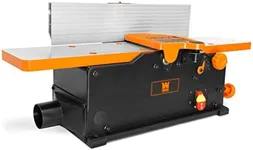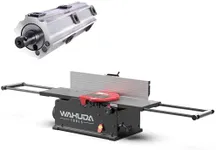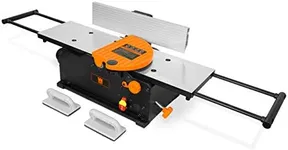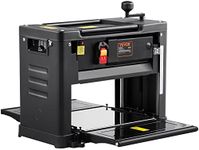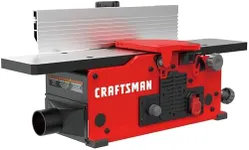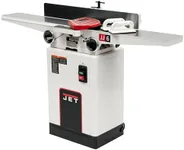Buying Guide for the Best Jointer Planer Combo
A jointer-planer combo is a versatile woodworking machine that combines the functions of a jointer and a planer. This tool is essential for anyone looking to achieve smooth, flat, and square surfaces on rough or uneven wood. When choosing a jointer-planer combo, it's important to consider several key specifications to ensure you select the right model for your needs. Understanding these specs will help you make an informed decision and get the best performance out of your machine.Cutting WidthThe cutting width refers to the maximum width of the wood that the machine can handle. This is important because it determines the size of the wood pieces you can work with. Cutting widths typically range from 6 inches to 12 inches or more. If you primarily work with smaller pieces of wood, a 6-8 inch cutting width may be sufficient. However, if you often work with larger boards, you might want to consider a machine with a cutting width of 10-12 inches or more.
Cutting DepthCutting depth is the maximum amount of material that can be removed in a single pass. This is crucial for efficiency and achieving the desired thickness quickly. Cutting depths usually range from 1/8 inch to 1/2 inch. For general woodworking, a cutting depth of 1/8 to 1/4 inch is often adequate. If you need to remove a lot of material quickly, look for a machine with a greater cutting depth.
Motor PowerMotor power, measured in horsepower (HP), affects the machine's ability to handle tough or dense wood. More powerful motors can handle larger and harder wood pieces without bogging down. Motor power typically ranges from 1 HP to 3 HP. For light to moderate use, a 1-1.5 HP motor may be sufficient. For heavy-duty use or working with very hard woods, consider a motor with 2-3 HP.
Cutterhead TypeThe cutterhead is the part of the machine that holds the blades and does the actual cutting. There are two main types: straight knife and helical (or spiral) cutterheads. Straight knife cutterheads are less expensive and easier to maintain but can be noisier and produce more tear-out. Helical cutterheads are quieter, produce a smoother finish, and handle figured wood better, but they are more expensive. Choose a cutterhead type based on your budget and the quality of finish you require.
Table SizeThe table size refers to the dimensions of the surface where the wood rests during operation. Larger tables provide better support for longer or wider pieces of wood, leading to more accurate cuts. Table sizes can vary, with lengths typically ranging from 30 inches to 50 inches or more. If you work with long or wide boards, a larger table will be beneficial. For smaller projects, a more compact table may suffice.
Fence AdjustabilityThe fence is a guide that helps keep the wood straight as it passes through the machine. An adjustable fence allows you to set different angles, which is useful for creating beveled edges or working with non-square pieces. Look for a fence that is easy to adjust and locks securely in place. If you frequently work with angled cuts or need precise adjustments, a highly adjustable fence is important.
Dust CollectionDust collection is a feature that helps manage the sawdust and wood chips produced during operation. Effective dust collection keeps your workspace cleaner and reduces the risk of respiratory issues. Machines may come with built-in dust ports that can be connected to a vacuum or dust collection system. If you value a clean workspace and want to minimize cleanup time, ensure the machine has a good dust collection system.
